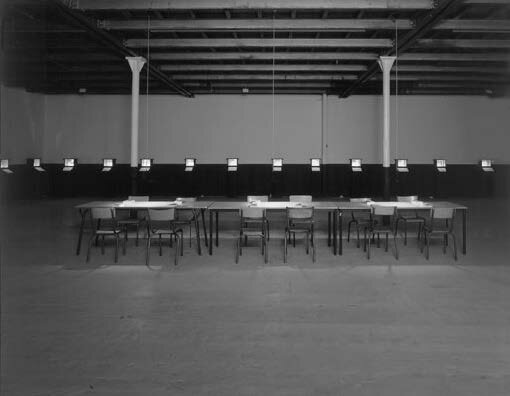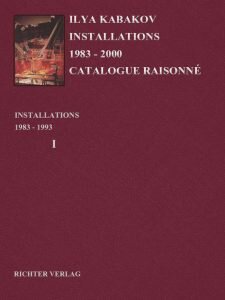52 Dialogues in the Communal Kitchen
YEAR: 1991
CATALOGUE NUMBER: 55
PROVENANCE
The artist
1992, Collection FRAC Bretagne, Rennes
EXHIBITIONS
Marseille, Ateliers Municipaux D’Artistes
52 Entretiens Dans la cuisine Communautaire, 20 Dec 1991 — 25 Jan 1992
Rennes, La Criée, Halle D’Art Contemporain
52 Entretiens Dans la Cuisine Communautaire, 4 Jul 1992 — 26 Sep 1992
DESCRIPTION
At the base of the installation were 52 photographs done in my studio in Moscow by Georgi Kizevalter. These are black-and-white photos of paintings and objects taken without special ‘reproduction’ lighting. A few of them are still in the same place they occupied in the studio; others have been dragged out of their corners into the light, and I am keeping them so that they will stand up and not be tossed around during the shooting. When I started to examine this series of photographs far away from my Moscow home (I was living during that first visit to the West in Paris at Yuri Kuper’s, my old Moscow friend), I was doused by a sudden wave of recollections, not about the paintings themselves, but about what happened to find itself in the photograph on the side: the semi-darkness and dirt of the studio, the wooden crates along the walls, the old floor and dark ceiling that hadn’t been whitewashed … About that world that ‘washed’ over us all, about that atmosphere of Moscow life surrounding us. Yuri and I decided to compose 52 dialogues, the same number as photographs. Each evening we would sit down at the microphone, I would place another photograph on the table and we would reminisce about what had been connected in our past lives with this or that theme present in the painting, what associations it evoked for us …
The installation that was made based on these dialogues and photographs looked like this: I requested that 52 identical vertical crates be made resembling low ‘altars.’ In the upper part, in a shallow niche, I arranged a photograph that was lit by a weak bulb. Directly above this niche, similar to a lectern, was a small slanted shelf holding the text (2-3 pages) of the dialogue about each photograph. In the large open space provided for this installation in both Marseille and Rennes, these cratesaltars stood along all four walls equidistant to one another, together forming a closed circle. In the middle of this ‘ring,’ in the center of the hall, I placed a long table on which were lying a few books-catalogs published specially for this installation – an edition of these 52 dialogues. What resulted was a unique kind of reading room of a library, but a library where people are submerged into the past. The lighting in the hall was muffled, and the viewer could freely wander around in this world of recollections: either moving from one shining ‘altar’ to another reading and peering inside the crate, or sitting down at the table and (with the light coming from three bulbs hanging low from the ceiling) read or page through everything, only here it was all gathered into a single book. In any case, he found himself encircled in a unique shimmering ring of space composed of a multitude of shining windows surrounding him.
Foreword to the book 52 Dialogues in the Communal Kitchen
These dialogues between Ilya Kabakov and Yuri Kuper took place not at all in a communal kitchen, but in a large, bright room; and not in a communal apartment, but in a clean, spacious studio. And not in Moscow, but in Paris. But all the rest of it is absolutely true, devoid of any inventions of the imagination whatsoever. Both artists were close friends for many years, their studios in Moscow in the 1970’s were right next to each other – and at that time they used to meet daily. For many years they would eat lunch every day in the cafe ‘Russian Tea’ on Kirov Street, where the waitresses and the name would change constantly: ‘Russian Tea,’ ‘Cutlets,’ ‘Russian Baranki,’ ‘Minute’ … But the crazy cloakroom man with the long black beard who was distinguished by an amazing talent didn’t go anywhere: he would toss the hats, caps, and headgear at the customers as they approached with such precision that they would land right on their heads …
The main thing that united them at the time, the thing that compelled them to understand one another with only half a word or no words at all, was that thick and stationary syrup, the atmosphere of that life in which they were immersed and which dictated to them the subjects of their paintings, and the material from which the paintings were made.
And of course, the concentrate of this atmosphere was for both of them the communal apartment in which a significant portion of their lives had transpired, and the center of any communal apartment was the communal kitchen. Therefore, when they had the idea in Paris in 1989 to discuss the paintings done in Moscow and what was connected with them, it wasn’t difficult for either of them to take off and fly away in their imaginations to those places and circumstances that are not destined either to disappear or to change.
Images
Literature









